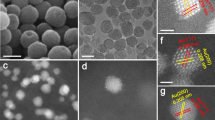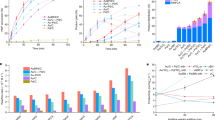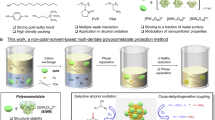Abstract
The catalytic activity of gold depends on particle size, with the reactivity increasing as the particle diameter decreases. However, investigations into behaviour in the subnanometre regime (where gold exists as small clusters of a few atoms) began only recently with advances in synthesis and characterization techniques. Here we report an easy method to prepare isolated gold atoms supported on functionalized carbon nanotubes and their performance in the oxidation of thiophenol with O2. We show that single gold atoms are not active, but they aggregate under reaction conditions into gold clusters of low atomicity that exhibit a catalytic activity comparable to that of sulfhydryl oxidase enzymes. When clusters grow into larger nanoparticles, catalyst activity drops to zero. Theoretical calculations show that gold clusters are able to activate thiophenol and O2 simultaneously, and larger nanoparticles are passivated by strongly adsorbed thiolates. The combination of both reactants activation and facile product desorption makes gold clusters excellent catalysts.
This is a preview of subscription content, access via your institution
Access options
Subscribe to this journal
Receive 12 print issues and online access
$259.00 per year
only $21.58 per issue
Buy this article
- Purchase on Springer Link
- Instant access to full article PDF
Prices may be subject to local taxes which are calculated during checkout






Similar content being viewed by others
References
Hughes, M. D. et al. Tunable gold catalysts for selective hydrocarbon oxidation under mild conditions. Nature 437, 1132–1135 (2005).
Hashmi, A. S. K. & Hutchings, G. J. Gold catalysis. Angew. Chem. Int. Ed. 45 7896–7936 (2006).
Corma, A. & Garcia, H. Supported gold nanoparticles as catalysts for organic reactions. Chem. Soc. Rev. 37, 2096–2126 (2008).
Haruta, M. Size- and support-dependency in the catalysis of gold. Catal. Today 36, 153–166 (1997).
López, N. et al. On the origin of the catalytic activity of gold nanoparticles for low-temperature CO oxidation. J. Catal. 223, 232–235 (2004).
Hutchings, G. J. Catalysis by gold. Catal. Today 100, 55–61 (2005).
Chen, M. S. & Goodman, D. W. Catalytically active gold: from nanoparticles to ultrathin films. Acc. Chem. Res. 39, 739–746 (2006).
Risse, Th., Shaikhutdinov, Sh., Nilius, N., Sterrer, M. & Freund, H. J. Gold supported on thin oxide films: from single atoms to nanoparticles. Acc. Chem. Res. 41, 949–956 (2008).
Liu, Y., Tsunoyama, H., Akita, T., Xie, S. & Tsukuda, T. Aerobic oxidation of cyclohexane catalysed by size-controlled Au clusters on hydroxyapatite: size effect in the sub-2 nm regime. ACS Catal. 1, 2–6 (2011).
Huang, J. et al. Propene epoxidation with O2 and H2: identification of the most active gold clusters. J. Catal. 278, 8–15 (2011).
Haruta, M. et al. Low-temperature oxidation of CO over gold supported on TiO2, α-Fe2O3, and Co3O4 . J. Catal. 144, 175–192 (1993).
Tsunoyama, H., Ichikuni, N., Sakurai, H. & Tsukuda, T. Effect of electronic structures of Au clusters stabilized by poly(N-vinyl-2-pyrrolidone) on aerobic oxidation catalysis. J. Am. Chem. Soc. 131, 7086–7093 (2009).
Herzing, A. A., Kiely, C. J., Carley, A. F., Landon, P. & Hutchings, G. J. Identification of active gold nanoclusters on iron oxide supports for CO oxidation. Science 321, 1331–1332 (2008).
Lupini A. R., Veith, G. M., Dudney, J. & Pennycook, S. J. Understanding catalyst stability through aberration-corrected STEM. Microsc Microanal. 15, 1408–1409 (2009).
Allard, L. F. et al. Evolution of gold structure during thermal treatment of Au/FeOx catalysts revealed by aberration-corrected electron microscopy. J. Electron Microsc. 58, 199–212 (2009).
Uzun, A., Ortalan, V., Hao, Y., Browning, N. D. & Gates, B. C. Imaging gold atoms in site-isolated MgO-supported mononuclear gold complexes. J. Phys. Chem. C 113, 16847–16849 (2009).
Lu, J., Aydin, C., Browning, N. D. & Gates, B. C. Imaging isolated gold atom catalytic sites in zeolite NaY. Angew. Chem. 51, 5842–5846 (2012).
Yoon, B., Häkkinen, H. & Landman, U. Interaction of O2 with gold clusters: molecular and dissociative adsorption. J. Phys. Chem. A 107, 4066–4071 (2003).
Lang, S. M., Bernhardt, T. M., Barnett, R. N., Yoon, B. & Landman, U. Hydrogen-promoted oxygen activation by free gold cluster cations. J. Am. Chem. Soc. 131, 8939–8951 (2009).
Hagen, J. et al. Coadsorption of CO and O2 on small free gold cluster anions at cryogenic temperatures: model complexes for catalytic CO oxidation. Phys. Chem. Chem. Phys. 4, 1707–1709 (2002).
Molina, L. M., Lesarri, A. & Alonso, J. A. New insights on the reaction mechanism for CO oxidation on Au catalysts. Chem. Phys. Lett. 468, 201–204 (2009).
Joshi, A. M., Delgass, W. N. & Thomson, K. T. Comparison of the catalytic activity of Au3, Au4+, Au5 and Au5− in the gas-phase reaction of H2 and O2 to form hydrogen peroxide: a density functional theory investigation. J. Phys. Chem. B 109, 22392–22406 (2005).
Lee, S. et al. Selective propene epoxidation on immobilized Au6–10 clusters: the effect of hydrogen and water on activity and selectivity. Angew. Chem. Int. Ed. 48, 1467–1471 (2009).
Guzman, J. & Gates, B. C. Structure and reactivity of a mononuclear gold-complex catalyst supported on magnesium oxide. Angew. Chem. Int. Ed. 42, 690–693 (2003).
Robinson, P. S. D., Khairallah, G. N., da Silva, G., Lioe, H. & O'Hair, R. A. J. Gold-mediated C–I bond activation of iodobenzene. Angew. Chem. Int. Ed. 51, 3812–3817 (2012).
Jia, C. J. & Schüth, F. Colloidal metal nanoparticles as a component of designed catalyst. Phys. Chem. Chem. Phys. 13, 2457–2487 (2011).
Tran, M. L., Zvyagin, A. V. & Plakhotnik, T. Synthesis and spectroscopic observation of dendrimer-encapsulated gold nanoclusters. Chem. Commun. 2400–2401 (2006).
Ledo-Suárez, A. et al. Facile synthesis of stable subnanosized silver clusters in microemulsions. Angew. Chem. Int. Ed. 46, 8823–8827 (2007).
Turner, M. et al. Selective oxidation with dioxygen by gold nanoparticle catalysts derived from 55-atom clusters. Nature 454, 981–983 (2008).
Liu, Y. M., Tsunoyama, H., Akita, T. & Tsukuda, T. Chem. Commun. 46, 550–552 (2010).
Shichibu, Y. & Konishi, K. HCl-induced nuclearity convergence in diphosphine-protected ultrasmall gold clusters: a novel synthetic route to ‘magic-number’ Au13 clusters. Small 6, 1216–1220 (2010).
Xie, S., Tsunoyama, H., Kurashige, W., Negishi, Y. & Tsukuda, T. Enhancement in aerobic alcohol oxidation catalysis of Au25 clusters by single Pd atom doping. ACS Catal. 2, 1519–1523 (2012).
Sanchez, A. et al. When gold is not noble: nanoscale gold catalysts. J. Phys. Chem. A 103, 9573–9578 (1999).
Hoober, K. L. & Thorpe, C. Egg white sulfhydryl oxidase: kinetic mechanism of the catalysis of disulfide bond formation. Biochemistry 38, 3211–3217 (1999).
Jaje, J. et al. A flavin-dependent sulfhydryl oxidase in bovine milk. Biochemistry 46, 13031–13040 (2007).
Dumont, E., Michel, C. & Sautet, P. Unraveling gold(I)-specific action towards peptidic disulfide cleavage: a DFT investigation. ChemPhysChem 12, 2596–2603 (2011).
Barton, D. G. & Podkolzin, S. G. Kinetic study of a direct water synthesis over silica-supported gold nanoparticles. J. Phys. Chem. B 109, 2262–2274 (2005).
Ntainjua, E. N. et al. The role of the support in achieving high selectivity in the direct formation of hydrogen peroxide. Green Chem. 10, 1162–1169 (2008).
Jadzinsky, P. D., Calero, G., Ackerson, C. J., Bushnell, D. A. & Kornberg, R. D. Structure of a thiol monolayer-protected gold nanoparticle at 1.1 Å resolution. Science 318, 430–433 (2007).
Häkkinen, H. The gold–sulfur interface at the nanoscale. Nature Chem. 4, 443–455 (2012).
Alves, L. et al. Synthesis and stabilization of subnanometric gold oxide nanoparticles on multiwalled carbon nanotubes and their catalytic activity. J. Am. Chem. Soc. 133, 10251–10261 (2011).
Santiago-González, B. et al. One step synthesis of the smallest photoluminescent and paramagnetic PVP-protected gold atomic clusters. Nano Lett. 10, 4217–4221 (2010).
Becke, A. D. Density-functional thermochemistry. III. The role of exact exchange. J. Chem. Phys. 98, 5648–5652 (1993).
Lee, C., Yang, W. & Parr, R. G. Development of the Colle–Salvetti correlation-energy formula into a functional of the electron density. Phys. Rev. B 37, 785–789 (1988).
Frisch, M. J. et al. Gaussian 03, Revision B.04 (Gaussian, 2003).
McLean A. D. & Chandler G. S. Contracted Gaussian basis sets for molecular calculations. I. Second row atoms, Z = 11–18. J. Chem. Phys. 72 5639–5648 (1980).
Krishnan, R., Binkley, J. S., Seeger, R. &. Pople, J. A. Self-consistent molecular orbital methods. XX. A basis set for correlated wave functions. J. Chem. Phys. 72 650–654 (1980).
Hay P. J. & Wadt, W. R. Ab initio effective core potentials for molecular calculations. Potentials for the transition metal atoms Sc to Hg. J. Chem. Phys. 82, 270–283 (1985).
Reed, A. E., Weinstock, R. B. & Weinhold, F. Natural population analysis. J. Chem. Phys. 83, 735–747 (1985).
Acknowledgements
Financial support from the Spanish Science and Innovation Ministry (Consolider Ingenio 2010-MULTICAT CSD2009-00050, Subprograma de apoyo a Centros y Universidades de Excelencia Severo Ochoa SEV 2012 0267, MAT2011-28009 and MAT2010-20442 projects) and Xunta de Galicia (Grupos Ref.Comp.2010/41) is acknowledged. M.J.Y. and E.L. acknowledge the support of the National Centre for Research Resources (5 G12RR013646-12) and the National Institute on Minority Health and Health Disparities (G12MD007591) from the National Institutes of Health and of the National Science Foundation for support with grants DMR-1103730 and PREM: NSF PREM Grant # DMR 0934218. We also acknowledge the support of Consejo Nacional De Ciencia y Tecnología. J.N. expresses his gratitude to Consejo Superior de Investigaciones Científicas for a JAE Fellowship.
Author information
Authors and Affiliations
Contributions
A.C. conceived, designed and directed the study and the analysis and interpretation of results. P.C. performed catalyst synthesis, characterization and testing. E.M. participated in catalyst synthesis. M.J.S. and J.N. carried out catalyst testing. M.B. designed and carried out the theoretical study. M.J.Y., E.L. and A.P. performed the HR-STEM characterization. M.A.L-Q. and D.B. synthesized and characterized the isolated size-controlled clusters. G.G. did the XAS measurements. A.M. collaborated in HR-STEM characterization. The manuscript was co-written by P.C., M.B. and A.C.
Corresponding author
Ethics declarations
Competing interests
The authors declare no competing financial interests.
Supplementary information
Supplementary information
Supplementary information (PDF 5252 kb)
Rights and permissions
About this article
Cite this article
Corma, A., Concepción, P., Boronat, M. et al. Exceptional oxidation activity with size-controlled supported gold clusters of low atomicity. Nature Chem 5, 775–781 (2013). https://doi.org/10.1038/nchem.1721
Received:
Accepted:
Published:
Issue Date:
DOI: https://doi.org/10.1038/nchem.1721
This article is cited by
-
The reformation of catalyst: From a trial-and-error synthesis to rational design
Nano Research (2024)
-
Regulating the hydrogenation selectivity of platinum using a two-dimensional zeolite
Science China Materials (2024)
-
Core–shell CoN@Co ultra-stable nanoparticles on biochar for contamination remediation in water and soil
Carbon Research (2024)
-
Advances in heterogeneous single-cluster catalysis
Nature Reviews Chemistry (2023)
-
Theoretical investigation of copper clusters using the electron propagator theory
Journal of Chemical Sciences (2023)



